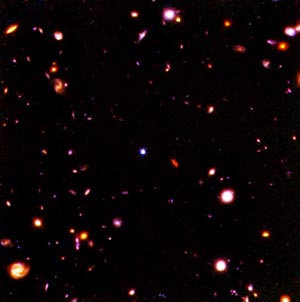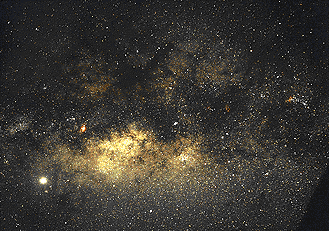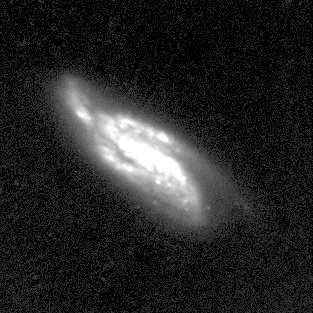What is WIRE?
WIRE is a 30-cm infrared telescope designed to pick starburst
galaxies out of the crowd. It will be able to see typical starburst galaxies out to
a distance of 3-5 billion light years. Thus, WIRE will help to determine starburst
evolutionary history during the past few billion years or so. WIRE will be able to
determine whether starburst galaxies do in fact represent the main source of all stars
that we see around us today. WIRE will also be able to determine the odds that our
own Sun formed in a burst of star-formation within the Milky Way, some 4.6 billion years
ago.

Hubble Deep-Field
|
This is a Hubble Space Telescope (HST) Deep Field Image in
Infrared. HST has uncovered the faintest galaxies ever seen. Astronomers
believe some of these galaxies could be over 12 billion light-years away, making
them the farthest objects ever seen. If these galaxies are 12 billion years old,
they must have formed very quickly, but how? |

The Milky Way Galaxy
|
This is an image of our own Milky Way Galaxy.
The Milky Way was formed almost 10 billion years ago. Was it formed in a
giant burst of star-formation? WIRE will help us to find the answer. We will
learn how the universe evolved, including the formation of our own galaxy. |
WIRE will also see ultraluminous starbursts far back
into the early universe. Studies with the Hubble Space Telescope and the giant Keck
Telescope on Mauna Kea in Hawaii have begun to reveal the star-formation history of the
early universe. These telescopes have taken pictures that reveal a myriad of small,
irregular-shaped galaxies that appear to be undergoing bursts of star-formation. The
colors and the energy sources of these small galaxies imply that these big telescopes are
seeing galaxies form from smaller "chunks".

NGC 4088
|
This is Galaxy NGC
4088. It is a spiral galaxy that is also undergoing a burst of star formation. |
Is that all of the picture? We don't know yet.
The problem is that the Hubble Space Telescope and the Keck Telescopes can only see
old stars or the minority of young stars that are visible at the edges of the clouds from
which they formed. These telescopes may be seeing mainly smallish galaxies because
those are the types of starburst galaxies that emit the most visible and ultraviolet light
out of their star-forming clouds. A large fraction of the stars that formed in the
early Universe may be in much bigger starbursts, ones that do not stand out in the images
taken with big visible-light telescopes. WIRE will be able to find out if the old
populations that are observed in modern galaxies originated in huge bursts of
star-formation.
Also see What is WIRE?
[Next]
Last Updated: 12/2/98


